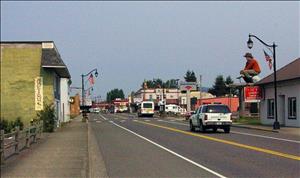Sumas is located in Whatcom County, approximately 25 miles northeast of the county seat of Bellingham. It shares its northern border with the Canadian province of British Columbia, and is a major border crossing. Sumas incorporated on June 18, 1891. In 2000, Sumas's population was 960.
Land Without Trees
The Nooksack Indians lived in the area that later became Sumas in the millennia prior to the first non-Indian settlement in the 1870s. Sumas -- pronounced “Soo-mass” -- means “land without trees”; the name comes from the Cowichan, who also lived in the region. The Sumas name was also given to Sumas Prairie, a flat, flood-prone lowland that stretches north into British Columbia, as well as Sumas River, Sumas Lake (drained in the 1920s), and Sumas Mountain (there are actually two: “American Sumas” east of Everson, Washington, and “Canadian Sumas” northeast of Abbotsford, B.C.).
The first permanent non-Indian settler in Sumas was Robert Johnson, who arrived in 1872, but it was another 10 years before the little settlement grew to the point that it began to develop into an actual community. In its earliest incarnation, it was known as Sumas City. The plat for the town of Sumas was filed on April 24, 1889, and it was incorporated on June 18, 1891.
In 1891 Sumas became a major railroad hub when three railroads, the Seattle Lake Shore & Eastern, the Bellingham Bay and British Columbia, and the Canadian Pacific, were linked there. A customs office opened in Sumas that same year. The town’s population quickly passed 2,000, and it was a lively place, with 11 saloons. But much of that evaporated during the economic depression that struck the country between 1893 and 1897.
Mining and Bulldogging
In August 1897 Sumas resident Jack Post (d. 1941), accompanied by Russ Lambert and Lyman Van Valkenburg, discovered gold just north of nearby Mt. Baker, setting off a rush of excited prospectors into the region. By the following spring 2,000 men had staked claims. Sumas became a supply center for miners headed to Mt. Baker and briefly benefited from a population boom that just as quickly reversed itself when the boom went bust. But the “Mt. Baker Gold Rush” left a lasting legacy of mining in the region. The Lone Jack Mine (named after Post) operated until 1924, and a second mine, the Boundary Red Mountain Mine, yielded more than $1 million in gold between 1913 and 1946.
A famous part of Sumas’s history is the Sumas Roundup, a large rodeo which at its zenith in the 1920s attracted tens of thousands of people. The Roundup got its start in conjunction with a fair in 1923. It was such an unexpected success that in 1924 the fair was dropped and the rodeo became its own yearly show, with its own motto, “See ‘Em Buck.” The three-day event featured horse races, bucking, bulldogging (steer wrestling), and roping contests, and much more. Faux and genuine cowboys and cowgirls came from all over the Western United States and Canada to compete. The rodeo was discontinued between 1930 and 1936 because of the Depression, but returned in 1937 and entertained thousands every year through 1940.
Sumas is one of the major ports of entry between Canada and the United States in northwestern Washington. Although its population remained stagnant for decades, fluctuating between 600 and 750 between 1930 and 1990, the 2000 census reported a population of 960, and this uptick appears to have continued during the first decade of the twenty-first century. Located on a flood plain, the town has suffered a number of floods throughout its history, with an especially severe flood in November 1990 causing millions of dollars in damage.

